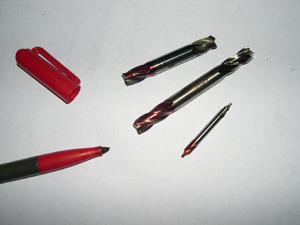By Weston Bye

Double-ended end mills and center drills present a dilemma; as one end dulls with use, eventually that end becomes unusable. In the case of center and spotting drills, as the tool dulls, the tip of the drill may break off and remain lodged in the hole, ruining the detail or requiring tedious salvage and retrieval.
A dull cutter generally gives indication of wear with higher feed forces required. A single-ended tool may simply be retired or set aside for retirement or re-sharpening later.
The double-ended cutter, however, remains in the tool drawer or bench top while the opposite end is used. Unless the used-up end is obviously damaged, blue, or otherwise identifiable as worn, it is possible to install the tool with the worn end presented to the work. At best, you will realize your mistake and have to take the time to turn the tool around. At worst, the tool breaks or cuts erratically and damages the workpiece.
After some years, I have mostly learned not to push a cutter beyond its useful life, and now when I identify one end of a double-ended cutter as spent, I immediately paint that end with a red permanent marker so I don’t use it again.
Thanks Wes. Your subscription has been extended an issue!
Please do us a tremendous favor and forward this e-mail to your machining friends!
